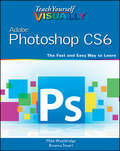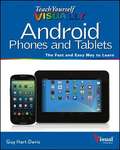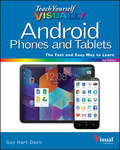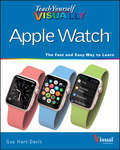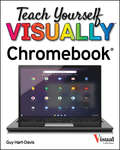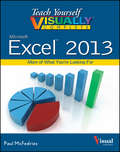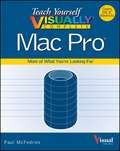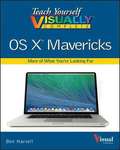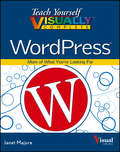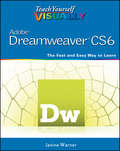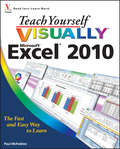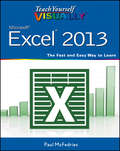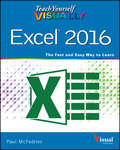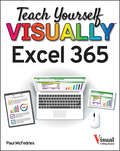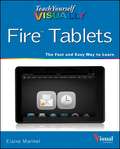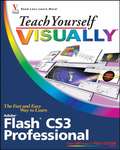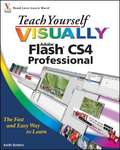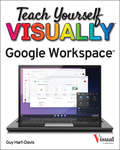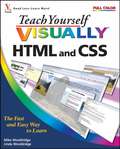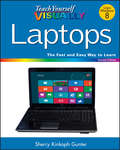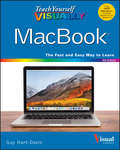- Table View
- List View
Teach Yourself VISUALLY Adobe Photoshop CS6 (Teach Yourself VISUALLY (Tech))
by Mike Wooldridge Brianna StuartGets visual learners up to speed on the newest enhancements in Photoshop Photoshop is constantly evolving, and the newest version offers great new tools for photographers. This popular guide gets visual learners up to speed quickly; previous editions have sold more than 150,000 copies. With colorful screen shots illustrating the step-by-step instructions, this book is perfect for Photoshop newcomers and for visual learners who are upgrading from an earlier version. It covers setting up the software, importing images from the camera, using all the tools, creating an online gallery, and more. Covers the most important features of Photoshop CS6, including importing photos from a digital camera, retouching and repairing damaged photos, enhancing digital images, and adding custom 3-D effects Explains how to edit images for the web, create an online photo gallery, and incorporate graphics into desktop publishing programs Explores color management, using palettes, compositing, using layers, applying gradients, setting type, and working with filters Features step-by-step instructions and full-color illustrations designed for those who learn best when they see how things are done Teach Yourself VISUALLY Photoshop CS6 gets visual learners ready to take advantage of everything the newest version has to offer.
Teach Yourself VISUALLY Android Phones and Tablets
by Guy Hart-DavisThe fast and easy way for visual learners to get up to speed on AndroidPacked with step-by-step, image-driven guidance, this must-have Visual book offers the latest tips for getting the most out of your Android devices that run on the most recent versions of the Android OS. Through the use of clear, visual instruction, you will learn how to access, download, and enjoy books, apps, music, and video content as well as send photos and emails, edit media on your phones and tablets, sync with desktop and other devices and services, and effectively multi-task.Offers beginning-to-intermediate level coverage on the latest Android features for both experienced Android users and those new to the Android familyAddresses a variety of quirks unique to the Android phones and tablets and discusses how to handle themFeatures full-color illustrations to accompany the step-by-step instructions, aimed at readers who learn best when they can see how things are doneTeach Yourself VISUALLY Android Phones and Tablets is an ideal resource if you learn best via visual guidance!
Teach Yourself VISUALLY Android Phones and Tablets: The Fast And Easy Way To Learn (Teach Yourself VISUALLY (Tech))
by Guy Hart-DavisExperience all your Android device has to offer! Teach Yourself VISUALLY Android Phones and Tablets, 2nd Edition is the perfect resource if you are a visual learner who wants to master the ins and outs of the Android operating system. With step-by-step instructions driven by targeted, easy-to-understand graphics, this informative book shines a light on the features, functions, and quirks of the Android OS—and shows you how to use them. With the guidance provided by this easy to follow resource, you will quickly access, download, and enjoy books, apps, music, and video content, as well as photos, emails, and other forms of media, right from your phone or tablet! This book is perfect for Android users at beginner to intermediate levels. The Android operating system is graphics intensive, which is why a visual guide is the best way to navigate your Android device. Now that the Android OS is available on both phones and tablets, you can maximize the productivity and convenience of your devices by mastering the features, functions, and quirks of this operating system. Explore the latest Android features and functions Peruse full-color illustrations that walk you, step-by-step, through instructions for using the Android operating system Discover how to access, download, and enjoy multimedia content Sync your Android devices to maximize their capabilities Teach Yourself VISUALLY Android Phones and Tablets, 2nd Edition is the top resource for visual learners wanting to further explore the capabilities of Android devices.
Teach Yourself VISUALLY Apple Watch
by Guy Hart-DavisWatch. Learn the features visually with 400 full-color screen shotsMaster the basic Apple Watch functions and customize your settingsGet optimal performance from your smartwatch with expert tipsFind the best apps and services to fit your personal needsThe Apple Watch's graphics-intensive touch interface is perfect for visual learners, and this guide mirrors that feature with a highly visual approach to using both the OS and the device itself. With full coverage, plenty of screen shots, and expert tips and tricks, Teach Yourself VISUALLY Apple Watch is the companion you cannot be without.
Teach Yourself VISUALLY Chromebook (Teach Yourself VISUALLY (Tech))
by Guy Hart-DavisTeach yuorself VISUALLYTM Are you a visual learner? Do you prefer instructions that show you how to do something — and skip the long-winded explanations? If so, then this book is for you. Open it up and you'll find clear, step-by-step screen shots that show you how to tackle the most useful Chromebook tasks. Each task-based spread covers a single technique, sure to help you get up and running on your Chromebook in no time. You'll learn to: Set up your Chromebook from Scratch Configure Chrome OS to work your way Connect your Android phone Enjoy email, chat, and video chat Master your schedule and tasks Designed for visual learners Two-page lessons break big topics into bite-sized modules Succinct explanations walk you through step by step Full-color screen shots demonstrate each task Helpful sidebars offer practical tips and tricks
Teach Yourself VISUALLY Complete Excel
by Paul McfedriesGet the basics of Excel and then go beyond with this new instructional visual guideWhile many users need Excel just to create simple worksheets, many businesses and professionals rely on the advanced features of Excel to handle things like database creation and data analysis. Whatever project you have in mind, this visual guide takes you step by step through what each step should look like. Veteran author Paul McFedries first presents the basics and then gradually takes it further with his coverage of designing worksheets, collaborating between worksheets, working with visual data, database management and analysis, VBA, and more.Offers step-by-step instructions on a variety of tasks, some everyday and some more uniqueShows you how to create basic spreadsheets, insert functions and formulas, work with pivot tables, and moreFeatures a two-color interior features numerous screen shots to enhance your learning process for tasks such as creating and managing macros, generating and working with analytics, and using the advanced tools Offering you a deep dive into Microsoft Excel, this book is the complete package for learning Excel with step-by-step, clear visual instructions.
Teach Yourself VISUALLY Complete Mac Pro
by Paul McfedriesGet up to speed on Apple's visionary new redesign of the desktop computerIt has the sleek lines of a starship, all-Flash memory, rock-solid architecture, and connection ports galore. Now you can take a deep dive through all the killer new features and functions of Apple's visionary new Mac Pro desktop computer with our equally impressive new guide, Teach Yourself VISUALLY Complete Mac Pro. Clear screenshots and lessons show you how to tackle not only beginning but also intermediate and advanced functions. You'll soon be customizing your Mac Pro, creating digital media, and enjoying even more cool stuff with the new Mavericks OS.Explains how to use and optimize the dazzling new Mac Pro desktop computer and its OS X operating system, MavericksCovers the basics, then dives deeper into more advanced techniques, tasks, apps, and functionsProvides practical information using high-resolution, two-color screenshots and quick, bite-sized, side-by-side lessonsPerfect for visual learners who prefer instructions that show, rather than tell, how to do thingsJump to warp speed on your dazzling new Mac Pro with Teach Yourself VISUALLY Complete Mac Pro.
Teach Yourself VISUALLY Complete OS X Mavericks
by Ben HarvellA deep dive into OS X MavericksIf you want to quickly cover the basics of Apple's new operating system, OS X Mavericks, and then delve deeper into the topic, this is the book for you. Using clear, step-by-step screenshots, Teach Yourself VISUALLY Complete OS X Mavericks shows you how to tackle not only beginning but also intermediate and more advanced functions. Two-page, side-by-side lessons break big topics into smaller bits, and you'll find helpful sidebars with plenty of practical tips and tricks. If you're a visual learner looking for enhanced coverage of OS X Mavericks, this new guide has more of what you're looking for.Explains how to use and optimize the newest OS X operating system, MavericksCovers the basics, then delves deeper into more advanced techniques and tasksUses succinct explanations and high-resolution screenshotsPerfect for visual learners who prefer instructions that show, rather than tell, how to do thingsWhen it comes to OS X Mavericks, find more of what you're looking for in Teach Yourself VISUALLY Complete OS X Mavericks.
Teach Yourself VISUALLY Complete WordPress
by Janet MajureTake your WordPress skills to the next level with these tips, tricks, and tasks Congratulations on getting your blog up and running with WordPress! Now are you ready to take it to the next level? Teach Yourself VISUALLY Complete WordPress takes you beyond the blogging basics with expanded tips, tricks, and techniques with clear, step-by-step instructions accompanied by screen shots. This visual book shows you how to incorporate forums, use RSS, obtain and review analytics, work with tools like Google AdSense, and much more.Shows you how to use mobile tools to edit and update blogs, implement SEO, and incorporate blogs into other services such as Facebook, LinkedIn, and Twitter and vice versaShares insight on best practices for maximizing WordPress.com and WordPress.org, customizing templates, and creating written and visual content Offers advice for working with a variety of other tools and sites to get maximum results for your blog Beef up your blog completely with Teach Yourself VISUALLY Complete WordPress!
Teach Yourself VISUALLY Computers
by Paul McfedriesAre you a visual learner? Do you prefer instructions that show youhow to do something -- and skip the long-winded explanations?If so, then this book is for you. Open it up and you'll find clear,step-by-step screen shots that show you how to tackle more than 135basic computer tasks. Each task-based spread includes easy, visualdirections for performing necessary operations, including: Comparing types of computersSelecting memory and storage optionsUsing Windows® or Mac OS® XWorking with digital mediaExploring e-mail and the WebProtecting your privacy onlineHelpful sidebars offer practical tips and tricksFull-color screen shots demonstrate each taskSuccinct explanations walk you through step by stepTwo-page lessons break big topics into bite-sized modules
Teach Yourself VISUALLY Digital Photography
by Chris BucherAll-new update to this complete photography guide-over 125 photography tasks explained!Teach Yourself VISUALLY Digital Photography, Fourth Edition is a brand new take by a brand new author and professional photographer, who packs this book with heaps of essential tasks and new photos. Step-by-step screen shots show you best practices for completing more than 125 digital photography activities, including composing and lighting pictures; mixing and matching focus and lens settings; cropping, resizing, and sharpening photos; and enhancing photos with software. You'll find great tips and tricks for capturing your best photos and turning them into impressive prints and photo-based projects.As digital photography technology and photo-editing software evolve, so do the latest digital photography techniquesExplores essential digital photography concepts, including composition, lighting, focus, sharpening, and enhancing photos with photo-editing softwareDemonstrates through step-by-step instructions and numerous, full-color screen shots and photos, so you can see exactly how to perform tasksOffers tips and tricks to help you make the best captures and turn them into impressive prints and photo-based projectsSee how to produce your best digital photographs ever with this easy-to-follow visual guide!
Teach Yourself VISUALLY Dreamweaver CS6
by Janine WarnerLearn to design and maintain content-rich websites the Visual way With more than 90 percent market share, Dreamweaver is the preferred tool for professional website design and production. For those who learn best visually, this colorful, step-by-step guide is the perfect way to learn the program and start building websites with "wow". Numbered steps and full-color screen shots show you just how to navigate the program, format and style text, create web-based forms and pages, build data-driven sites, and maintain a fully functioning website. All the enhancements of the newest version are covered. Dreamweaver allows you to create web pages without writing code; it is used by more than 90 percent of web designers Using numbered steps and full-color screen shots, this visual guide shows you how to perform more than 150 essential tasks in the newest version of Dreamweaver Covers applying style sheets, using dynamic HTML, adding style with images and multimedia, publishing and maintaining a website, using hyperlinks to navigate a site or to link to other sites on the Internet, and creating dynamic websites using databases Shows how to maximize Dreamweaver CS6 when formatting and styling text, creating web-based forms and pages with frames, maintaining a site, and building database-driven sites Perfect for beginners but also covers more advanced skills Teach Yourself VISUALLY Dreamweaver CS6 gives visual learners the knowledge and confidence they need to start building effective, eye-popping websites.
Teach Yourself VISUALLY Excel 2010 (Teach Yourself VISUALLY (Tech) #63)
by Paul McFedriesSee your way to super spreadsheets with Excel 2010 and this visual guide! If you're always hearing about the cool things that Excel can do, here's your chance to see how to do them! With pages of full-color, step-by-step instructions and crystal-clear screen shots, this guide shows you how to get the most out of Excel 2010. The book covers all the basics as well as Excel 2010's new features and functions, including a new interface and better collaboration tools. Crunch and chart your data over a network, over the Web, or at home-helpful tips on every page will get you there even faster! Provides a clear look at Excel 2010, the newest version of the world's leading spreadsheet application from Microsoft, and part of the new Microsoft Office 2010 suite Demonstrates how to create spreadsheets and charts, filter and sort data, work with PivotTable, and present your data-on a network, on the Web, or on your laptop Explores all features and functions in full-color pages packed with screen shots and other visual graphics that clearly show you how to accomplish tasks Includes practical examples, tips, and advice on how to use all the tools more effectively Get the very most out of Excel 2010 with this easy-to-follow guide!
Teach Yourself VISUALLY Excel 2013 (Teach Yourself VISUALLY (Tech) #141)
by Paul McFedriesThe step-by-step, visual way to learn Excel 2013 Excel can be complicated, but this Visual guide shows you exactly how to tackle every essential task with full-color screen shots and step-by-step instructions. You'll see exactly what each step should look like as you learn to use all the new tools in this latest release of the world's most popular spreadsheet program. In easy two-page lessons, author Paul McFedries shows you how to organize, present, analyze, and chart data, over the web or on a network. The Visual learning system is perfect for teaching Excel; previous editions of this book have sold more than 230,000 copies Covers common Excel 2013 tasks such as creating spreadsheets and charts, filtering and sorting data, and working with PivotTables Provides step-by-step instructions for each task Each step is illustrated with full-color screenshots Teach Yourself VISUALLY Excel 2013 offers visual learners the ideal way to master this popular but complex spreadsheet program.
Teach Yourself VISUALLY Excel 2016 (Teach Yourself VISUALLY (Tech))
by Paul McFedriesSee your way to Excel spreadsheet stardom with this visual guide If you're always hearing about the cool things Excel can do, here's your chance to see how to do them!Teach Yourself Visually Excel offers you a straightforward visual approach to working with the newest version of the world's leading spreadsheet program. Packed with visually rich tutorials and step-by-step instructions that will help you take your Excel skills to new heights, this friendly and approachable guide will have you creating, editing, and manipulating Excel spreadsheets in no time! Excel can seem daunting, but with Teach Yourself Visually Excel, you'll quickly and painlessly learn how to perform dozens of tasks, including creating spreadsheets and charts, filtering and sorting data, working with PivotTables, and so much more. Covering the latest additions and changes to the newest version of Excel, a series of easy-to-follow, full-color tutorials helps you to excel at working with Excel! Tutorials and step-by-step screenshots make lessons easy to follow and understand Helps you grasp the basic functions of Excel—and beyond Walks you through Excel s new features Clearly demonstrates how to organize, present, analyze, and chart data with Excel Whether you've never used Excel or just need to brush up on its new features, Teach Yourself Visually Excel will be the dog-eared resource you'll turn to again and again.
Teach Yourself VISUALLY Excel 365 (Teach Yourself VISUALLY (Tech))
by Paul McFedriesExcel-erate your Excel 365 knowledge with the celebrated Teach Yourself VISUALLY series In Teach Yourself VISUALLY: Excel 365, veteran tech educator and writer Paul McFedries delivers a practical, step-by-step guide to using the latest version of the world&’s most popular spreadsheet app. The book is filled with easy two-page lessons containing large-size screenshots and walkthroughs demonstrating common and useful tasks in Excel 365. You&’ll learn how to present, analyze, visualize, and organize your data, as well as how to: Create and fill spreadsheets, charts, tables, and PivotTables Filter and sort your data, use and create formulas, and organize your information Visualize your data with a variety of effective charts, graphs, and moreA can&’t-miss handbook perfect for anyone looking for straightforward and easy-to-follow tutorials on basic and advanced Excel techniques, Teach Yourself VISUALLY: Excel 365 offers users of previous Excel versions—and complete Excel newbies—a clear roadmap to mastering Excel.
Teach Yourself VISUALLY Fire Tablets
by Elaine MarmelExpert visual guidance to getting the most out of your Fire tabletTeach Yourself VISUALLY Fire Tablets is the comprehensive guide to getting the most out of your new Fire tablet. Learn to find and read new bestsellers through the Kindle app, browse the app store to find top games, surf the web, send e-mail, shop online, and much more! With expert guidance laid out in a highly visual style, this book is perfect for those new to the Fire tablet, providing all the information you need to get the most out of your device. Abundant screenshots of the Fire tablet graphically rich, touch-based Android interface provide easy-to-follow guidance.The Fire tablet's high capability and low price have made it a bestselling Android tablet. Beyond making Amazon transactions a seamless process, the device provides all the services tablet users have come to expect. This Teach Yourself VISUALLY guide explores the many features and content options available on the Fire tablet, allowing you to take full advantage of all the device has to offer.Find out how to use your Fire tablet to download books, music, and video contentAccess apps and send e-mails with the tablet that does it allSync your Fire tablet with other devices and servicesLearn to use the easy, intuitive multi-touch displayThe Fire tablet has become one of the most popular entertainment and media devices on the market. Teach Yourself VISUALLY Fire Tablets is the comprehensive guide that shows you what the Fire tablet can do for you.
Teach Yourself VISUALLY Flash CS3 Professional
by Sherry Kinkoph GunterClear, step-by-step screen shots arranged in two-page lessons show you how to tackle more than 140 Flash CS3 Professional tasks. No long-winded explanations, just easy, visual directions for performing such necessary operations as creating objects, symbols, and instances; controlling playback with the Timeline; adding interactivity with buttons; organizing project assets with the Library; creating animation with tweens; and adding sound and video . Helpful sidebars offer practical tips and tricks, and it's all presented for the visual learner.
Teach Yourself VISUALLY Flash CS4 Professional
by Keith ButtersAs the industry standard for creating lively Web animations, Flash allows you to develop animation content or turn existing graphics into dynamic Web page animations--the CS4 release guarantees a world of new and thrilling possibilities If you are a beginner-to-intermediate level Flash user, this book will get you up and running fast as you dive into the tasks of building animation sequences and using ActionScript to create interactive Web page components Contains 150 useful and interesting Flash tasks presented in full color that demonstrates how easy it can be to design rich and dynamic content for any Web site
Teach Yourself VISUALLY Google Workspace (Teach Yourself VISUALLY (Tech))
by Guy Hart-DavisMaster the ins and outs of Google’s free-to-use office and productivity softwareTeach Yourself VISUALLY Google Workspace delivers the ultimate guide to getting the most out of Google’s Workspace cloud software. Accomplished author Guy Hart-Davis offers readers the ability to tackle a huge number of everyday productivity problems with Google’s intuitive collection of online tools. With over 700 full-color screenshots included to help you learn, you’ll discover how to: Manage your online Google Calendar Master the files and folders in your Google Drive storage Customize your folders and navigate your Gmail account Create perfect spreadsheets, presentations, and documents in Google Sheets, Slides, and Docs Perfect for anyone who hopes to make sense of Google’s highly practical and free online suite of tools, Teach Yourself VISUALLY Google Workspace also belongs on the bookshelves of those who already find themselves using Workspace and just want to get more out of it.
Teach Yourself VISUALLY HTML and CSS
by Linda Wooldridge Mike WooldridgeAre you a visual learner? Do you prefer instructions that show you how to do something - and skip the long-winded explanations? If so, then this book is for you. Open it up and you'll find clear, step-by-step screen shots that show you how to tackle more than 175 tasks involving HTML and CSS. Each task-based spread covers a single technique, sure to help you get up and running with HTML and CSS in no time. You'll learn to: View HTML code in a browser Add and format text Prepare images for the Web Insert links to other pages Control layout with style sheets Add JavaScript to a Web page Helpful sidebars offer practical tips and tricks Succinct explanations walk you through step by step Full-color screen shots demonstrate each task Two-page lessons break big topics into bite-sized modules
Teach Yourself VISUALLY HTML and CSS (Teach Yourself VISUALLY (Tech))
by Guy Hart-DavisLevel-up your HTML and CSS web development skills with this dynamic, visual guide Teach Yourself VISUALLY HTML and CSS is the perfect resource for those of you who prefer to learn visually and would rather be shown how to do something – with crystal-clear screenshots and easy explanations – than suffer through long-winded explanations. You’ll find step-by-step walkthroughs showing you how to tackle over 120 individual tasks involving HTML and CSS. Each task-based spread covers a single technique, ensuring you learn first the basics and then more advanced topics one straightforward piece at a time. You'll learn to write HTML code in a text editor or an integrated development environment, add and format text, prepare images for the web, insert links to other pages, control layout with style sheets, add JavaScript to a web page, and more. You’ll also discover how to: Create websites that look great in 2023 and beyond with classic HTML and skills and the most modern tips and tricks for contemporary web coding Optimize your websites for performance and speed, ensuring every visitor gets the best possible experience Add modern elements to your code, including , , , and , and make your code accessible to as many people as possibleTeach Yourself VISUALLY HTML and CSS is your personal roadmap to understanding how to get the most out of HTML and CSS to create, format, and troubleshoot websites of all kinds. This book will get you to the next level of web development, quickly and easily.
Teach Yourself VISUALLY Laptops
by Sherry Kinkoph GunterThe fast and easy way to learn about buying, maintaining, and troubleshooting, a laptopHow do I find the right laptop for me? Now that I have a laptop, how do I set it up and maintain it? What are some tips for getting the most out of software systems? How do I begin to troubleshoot my laptop? If you are a visual learner and have ever asked yourself any of those questions, then this is just the book you need. Visual, step-by-step guidance walks you through finding the right laptop to meet your needs, getting comfortable with the latest versions of Windows and the Microsoft Office Suite, and understanding the most important security aspects of keeping your online experiences safe.Helps visual learners get comfortable and confident with their laptopsFeatures full-color screen shots and numbered, step-by-step instructions on how to get up and running Walks you through using the latest hardware add-ons, the Internet, and popular software applicationsTeach Yourself VISUALLY Laptops, Second Edition offers you an easy-to-follow and visually appealing way to learn!
Teach Yourself VISUALLY MacBook
by Brad MiserGet up and running quickly with all the latest updates to the MacBook The MacBook is an incredibly popular laptop choice, boasting light weight and tremendous speed. If you're a visual learner who is eager to get started with all that the MacBook has to offer, then this is the book for you! Packed with full-color photos and screen shots, this vital book walks you step by step through everything from the basics (such as powering on or shutting down the MacBook) to working with the Dashboard and its widgets to running the new Mac OS X Snow Leopard operating system. Veteran author Brad Miser escorts you through all the vitals and even offers invaluable advice for troubleshooting common problems. The MacBook is gaining popularity and this book is essential for visual learners who are eager to get started using their MacBook Covers the new Mac OS X Snow Leopard, as well as updates to iLife and MobileMe Lavish photos and screen shots offer you enhanced visual assistance while you learn the ins and outs of the MacBook Veteran author Brad Miser breaks down each topic to make it understandable for visual learners Keep this indispensible visual guide at arm's reach and get up and running with your MacBook the fast and easy way!
Teach Yourself VISUALLY MacBook (Teach Yourself VISUALLY (Tech))
by Guy Hart-DavisThe visual learner’s ultimate guide to the MacBook and macOS High Sierra Teach Yourself VISUALLY MacBook is your ultimate guide to getting up and running quickly with your new MacBook, MacBook Pro, or MacBook Air! Whether you’re new to computers or transitioning from a PC, this graphics-heavy guide will show you everything you need to know to get the most out of your new laptop. Clear, step-by-step instructions walk you through each task, with screenshots that help you follow along with confidence. You’ll learn how to manage files, work with macOS software, organize photos and media, set up email, access the internet, and adjust settings and preferences to make your MacBook work the way you work. You’ll also explore the features that bring computing to a whole new level, including iCloud, FaceTime, the App Store, and so much more! The Mac has long inspired a legion of loyal fans, and you’re about to find out why. From sleek design to intuitive interface, to an OS that just works, Apple has cornered the market on the high-end computing experience. The MacBook makes sublime computing portable, and this book shows you how to take advantage of all that your MacBook has to offer. Get acquainted with the latest macOS version and its new features Perform everyday tasks quickly and easily Customize preferences and settings to suit your needs Download new apps, video chat, save to the cloud, and much more! No confusing tech-speak, no vague instructions, and no complex tangents into obscure tasks. This friendly guide is packed with screenshots, easy-to-follow instructions, and a practical sensibility; you’re not launching the space shuttle, you just want to open your email. If you’re ready to explore all that your MacBook can do, Teach Yourself VISUALLY MacBook is your ideal companion.
